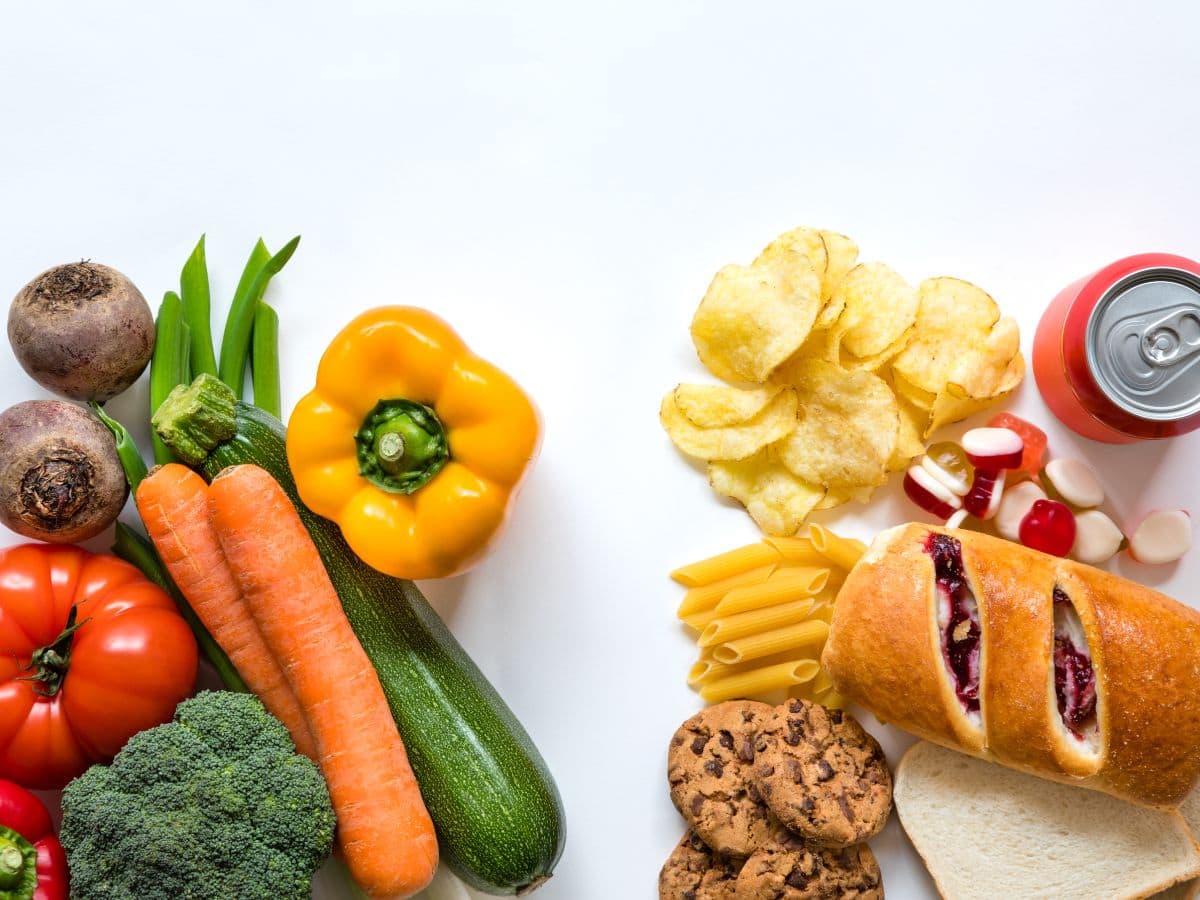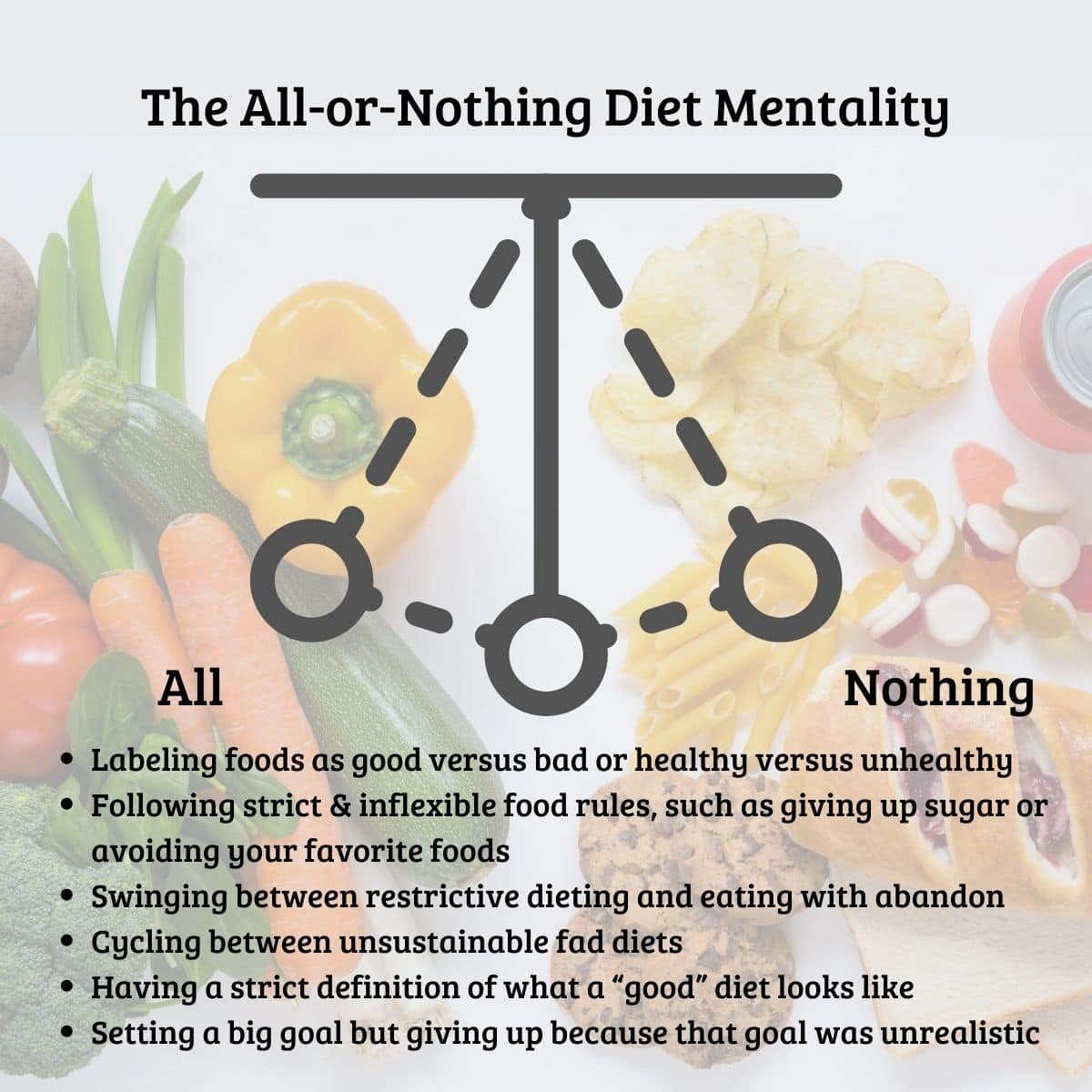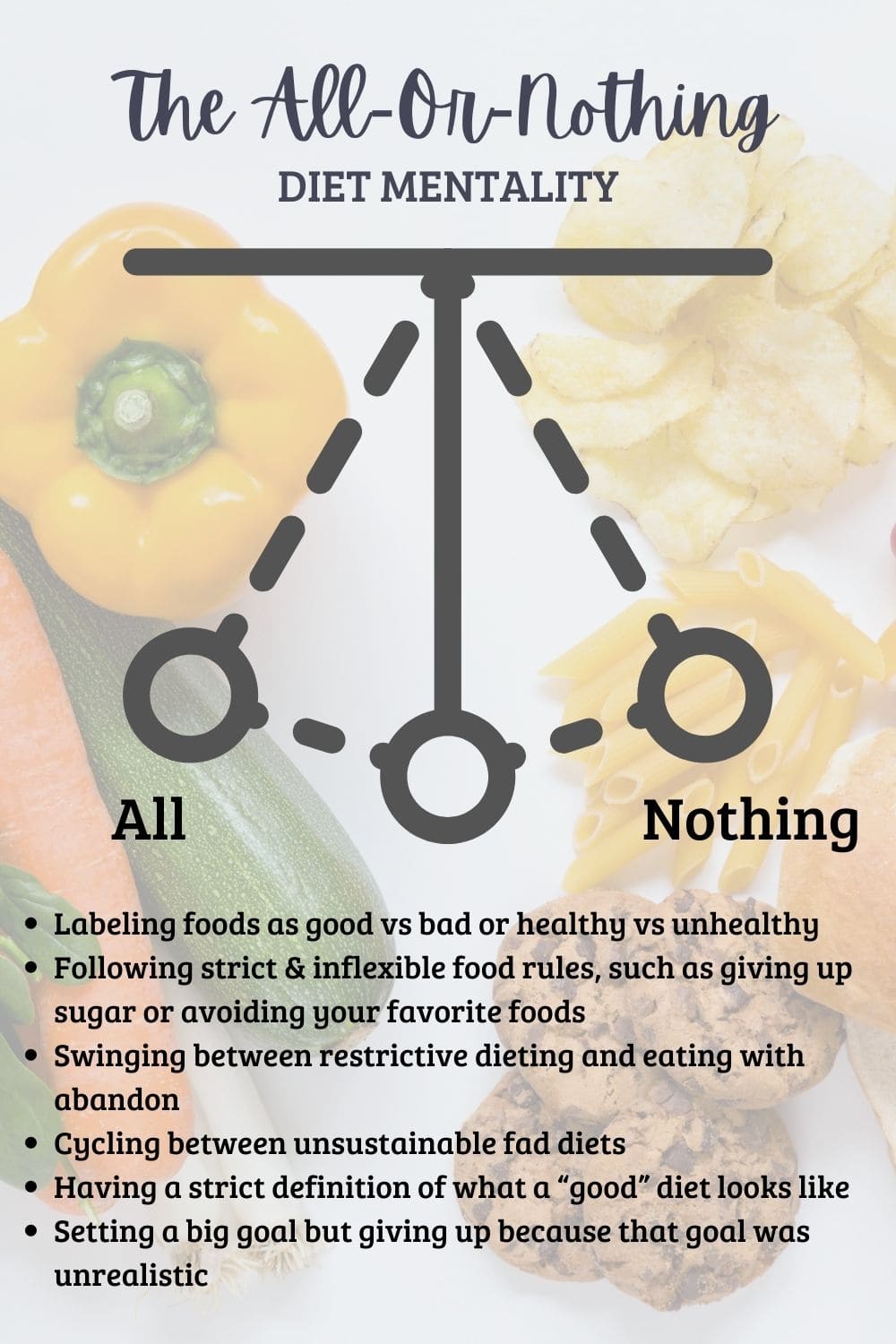How we view the world says a lot about our mental health and well-being. Frequently, the way we see the world depends on our thoughts, beliefs, and cognitions. Of course, not all our thoughts are helpful or even true, which can result in cognitive distortion.
A cognitive distortion is a flawed or inaccurate pattern of thinking that often leads to viewing the world through a negative filter.
While there are multiple types of cognitive distortions, many people have experienced all-or-nothing thinking.
All-or-nothing thinking, sometimes referred to as black-and-white thinking, involves perceiving the world as binary. It’s a tendency to see things as “good/bad” or “either/or,” with nothing in between. This thought pattern lends itself to perfectionism and can cause us to throw in the towel when things don’t go perfectly.
Unfortunately, we frequently find all-or-nothing thinking in the nutrition and health realm. In fact, this faulty thinking is so ubiquitous in diet culture that we can coin it the all-or-nothing diet mentality. This mentality often shows up in restrictive diets and unhelpful beliefs about food and health.
The good news is that we can challenge an all-or-nothing diet mentality. Read on to learn more about black-and-white thinking, the all-or-nothing diet mentality, and five steps you can take to break free from all-or-nothing dieting.
Table of Contents
What Is All-or-Nothing Thinking About Food
Do any of these statements sound familiar?
- I can’t eat that food because it is “bad” for me.
- Next week I will start eating “clean,” and I mean it this time.
- I gave into that cookie today, so I guess I blew my whole diet. I might as well give up entirely.
- I am going to give up eating chocolate starting tomorrow. In the meantime, let me finish all the chocolate in the house.
- I can’t be trusted around certain foods. I know I will eat the entire box if I have one or two.
These are examples of all-or-nothing thinking and how it can creep into our beliefs about food and our bodies.
All-or-nothing thinking is a cognitive distortion that can lead to believing in extremes and not considering the gray areas. When it comes to all-or-nothing thinking, you either succeed or fail; there is no room for a middle ground.
When it comes to eating, many people think of foods as good or bad, leading to restrictive food rules and an all-or-nothing diet mentality. With an all-or-nothing diet, there is no room for flexibility, which can set us up for failure and ultimately damage our self-esteem. It can also lead to a cycle of yo-yo dieting (or losing and regaining weight).

What Causes an All-or-Nothing Diet Mentality
An all-or-nothing diet mentality occurs when we think of foods or health as binary. For example, labeling foods as good or bad, healthy or unhealthy, fattening or not fattening, clean or toxic, and so on. We may even begin to label ourselves as good or bad based on our food choices. With all-or-nothing eating, you are either “all-in” or “all-out,” without any room for flexibility or moderation.
An all-or-nothing diet mindset often results from diet culture and years of restrictive dieting. This is because any new weight loss diet comes with a long list of food rules, and most diets or diet products are rooted in faulty all-or-nothing thinking.
For example, you need to eat this, or you shouldn’t eat that. You need to eat during this window of time and never eat after 7 pm. The list of “good” versus “bad” goes on and on.
Restrictive food rules such as these can train our minds to believe in extremes. We either follow the diet completely, without mistakes, or we fall off the wagon. An all-or-nothing diet cycle can occur as chronic dieters swing from one extreme to another, alternating between strict diets and eating with abandon.
Additionally, many people approach their personal health goals from the lens of all-or-nothing thinking, setting themselves up for failure. It’s not uncommon to set big, idealistic goals. But what happens when we inevitably encounter a barrier? Even small mistakes leave us defeated when we have an all-or-nothing approach to health.
All-or-Nothing Thinking Examples:
Some examples of all-or-nothing thinking include:
- Labeling foods as either/or (e.g., good foods versus bad foods, healthy versus unhealthy, toxic versus clean)
- Following strict and inflexible food rules, such as giving up sugar or avoiding your favorite foods
- Swinging between restrictive diets and eating with abandon
- Cycling between unsustainable fad diets
- Having a strict definition of what a “good” diet looks like
- Setting a big goal but giving up because that goal was unrealistic

Good vs. Bad Foods
Perhaps the most common example of all-or-nothing thinking in nutrition is labeling foods as good versus bad and, thereby, defining ourselves as good or bad based on our eating behaviors.
The problem with this form of dichotomous thinking is that it can attribute far too much power to certain foods and leave us feeling like failures if we succumb to these “bad foods.”
For many of us, foods labeled as bad are powerful enough to ruin our day and cause feelings of guilt and shame. For some, consuming “bad” foods may even warrant punishment, such as purging or overly restrictive diets, which can lead to a host of problems.
Research suggests that those engaged in rigid dietary methods are more likely to report symptoms of eating disorders, higher anxiety, depression, and excessive concern with body size and shape compared to those with flexible dietary strategies (1).
Real-Life Scenarios
So now that we know the definition of all-or-nothing eating, let’s look at how it can impact our lives. Do any of these scenarios sound familiar?
You start a new diet, and everything is going well at first. You’ve been on similar diets to lose weight in the past, but you’re optimistic that this time will be different. Your stomach is rumbling most days, but you can ignore that for a while. Then comes the party…
You attend a gathering with some friends. You have all your favorite foods that aren’t allowed on this new diet, and then you have some more.
The following day, you feel like a failure, which leads to a weekend of binge eating. Unfortunately, this pattern of dieting and bingeing has played out before and will likely play out again with the next fad diet.
Or how about this scenario:
You work hard Monday through Friday, including following a set of strict food rules. You love ice cream, pizza, and chocolate, but those are strictly “cheat day foods.” When it’s finally the weekend, you indulge in these foods until you are uncomfortably full, only to restrict again on Monday.
One day, your best friend invites you to a pizza place on a Tuesday, and you have to decline. You skip spending time with your friend because you are nervous about having pizza in the middle of the week. You rationalize that pizza is weekend food.
Why Is It a Problem?
An all-or-nothing diet mentality is a problem because it traps us in a cycle of restrictive dieting. Additionally, it does not allow for the flexibility needed to build healthy, sustainable eating patterns.
In fact, all-or-nothing thinking may be associated with:
- Lower self-esteem and poor body image (1)
- Perfectionism and fear of failure (2)
- Binge eating (1)
- Anxiety and depression (1,3,4)
- Increased risk of disordered eating (1)
- Lower resiliency in the face of hardships
- Negative emotions and thoughts (1,4)
- Loss of control around certain foods (2)
How to Stop All-or-Nothing Eating
The good news is that we can overcome cognitive distortions with time and practice. Try these five steps to stop the all-or-nothing diet mentality.
Step 1. Learn to recognize an all-or-nothing diet mentality
The first step to overcoming all-or-nothing eating is to identify our binary or dichotomous thoughts. How can we identify all-or-nothing thinking when it comes to nutrition? Try asking the following questions:
- Do I set rigid or restrictive rules around food and eating? If so, what are those rules?
- Do I label foods as “good foods” vs. “bad foods?”
- What happens when I eat a food that I deem “bad?”
- Do I use the terms “never,” “always,” or “nothing” frequently? (These words can be a big clue that you are in an all-or-nothing cycle.)
Begin to recognize that the all-or-nothing diet mentality produces an uncompromising attitude that can make us feel stuck or unable to adapt. On the other hand, flexible thinking allows us to see a situation from all angles.
Once we have identified our thought patterns as two ends of a spectrum, we can challenge this all-or-nothing thinking by finding the middle ground.
Step 2: Look for shades of gray
Checking for alternative views of a situation or different possible outcomes-shades of gray-can create a more balanced outlook on life.
In all-or-nothing or black-and-white thinking, foods can be “good” or “bad,” and rules are followed or broken. This strict form of thinking can set us up for failure and leave us feeling guilty when something goes wrong.
By monitoring our thought patterns for black-and-white thinking, we can start to challenge our cognitions around food and move toward the gray space.
You can think of the gray space as the area between black-and-white thinking. It is where you can explore your relationship with food and your body without judgment. There are no unhealthy foods in the gray space. Instead, we can see that all foods fit into our diets and lives.
For some, this gray space may mean learning to build a balanced diet that includes all their favorite foods. For others, it may look like reframing their definition of health. Ultimately, exploring the gray middle ground helps us adopt eating patterns that are flexible and sustainable.
Try the following activity to start discovering shades of gray:
- First, describe a situation when you experienced all-or-nothing thinking.
- What was the “all” in this scenario, and what was the “nothing?”
- What other possibilities or gray areas were there for that situation?
Step 3: Stop thinking of foods as good or bad
Remove good vs bad food from your vocabulary. Most importantly, stop defining yourself as a good or bad person based on your food choices.
You can think of this step as neutralizing or balancing your thoughts about food. By balancing your mindset, you remove the negative associations surrounding “bad” foods and recognize that your favorite foods can have a place in a balanced diet.
The benefit of no longer labeling foods as good or bad is that it neutralizes the power held over us by what we consider “bad” foods. If all foods are allowed in the diet, we will be less likely to restrict, binge, or feel out of control around those “bad” foods.
For some, the idea of allowing all foods in the diet may trigger fears that it could result in unrestrained or binge eating. Notice that this is another example of an all-or-nothing thought pattern in which you can either eat no cookies or all the cookies with no room for moderation. In general, the opposite is usually true. Once previously “bad” foods are allowed in your diet, you’ll likely notice that your mind and your plate are more balanced.
Step 4: Question the food rules
Who says that you can’t eat pizza during the week? Or that added sugar has no place in the diet? Strict food rules like these are frequently rooted in black-and-white thinking because you are either “all in” or “all out.”
Try this instead: Give yourself unconditional permission to eat the foods you enjoy without the harsh food rules.
Step 5: Set small, achievable goals
The final step to overcoming all-or-nothing eating is to set achievable and sustainable health goals. So many individuals have fallen into the trap of setting health goals that are daunting and demanding.
Imagine you’re working toward a goal but make a small mistake along the way. All-or-nothing thinking might cause you to label yourself as a failure for that misstep.
For example, perhaps you would like to start meal planning more often so that you won’t be as reliant on takeout. An all-or-nothing goal might be to make an eating plan for all meals and snacks for the entire week. It’s not realistic! On the other hand, an achievable goal could be planning three meals for the following week.
Now it is your turn. Have you ever set a goal that was so big it was impossible to achieve? What might you do instead?
When to Seek Additional Support
Sometimes, all-or-nothing thinking can be associated with more severe issues such as depression, anxiety, PTSD, and eating disorders. If that is the case, it is best to work through cognitive distortions with the help of a therapist or mental health professional.
It’s never a bad idea to seek support from a mental health professional, especially if your thoughts or emotions interfere with your daily life.
Final Thoughts on the All-or-Nothing Diet Mentality
Thinking in extremes- not considering the gray areas of a situation- is known as all-or-nothing thinking. Thoughts like this often label foods as either “all good” or “all bad,” resulting in an all-or-nothing diet mentality.
Additionally, all-or-nothing thinking traps can produce an inflexible attitude and make us feel stuck or overwhelmed. Checking for alternative views of a situation or shades of gray is one way to create a more balanced outlook.
Confronting all-or-nothing thinking can be daunting, but it is crucial for building long-term healthy eating patterns free from restrictive food rules. By challenging all-or-nothing thoughts, we can take steps to build a better relationship with food and ourselves.
Looking for even more information about reframing negative thoughts? Check out these powerful affirmations for health to learn more.

